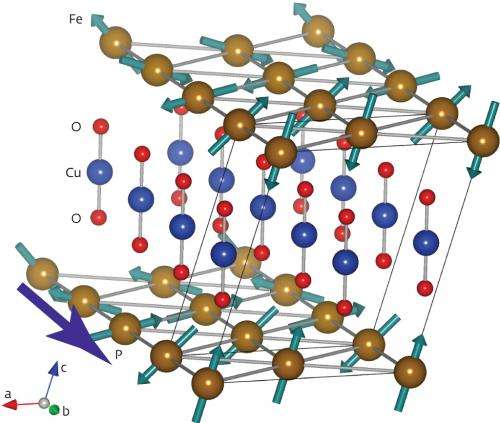A new way in which magnetism and electric polarization are coupled has been discovered in CuFeO2

Magnetism and electricity are two of the fundamental forces of nature. Combining them in a single multiferroic material in which one controls the other is not only of basic interest, but also relevant for practical applications. "Multiferroic materials can be used as magnetic sensors that change the sign of their electric polarization with a small magnetic field," says Yoshikazu Tanaka from the RIKEN SPring-8 Center in Harima. After studying the properties of the multiferroic CuFeO2, Tanaka and his colleagues have been able to verify a new mechanism by which magnetism and electricity can be coupled in a single material.
There are different ways in which magnetism and electric polarization, so-called ferroelectricity, are coupled in multiferroics. An understanding of these effects is important, because not only are multiferroics quite rare, but a better understanding of their properties might also help to develop materials where these effects are suitably strong for applications.
The researchers studied the magnetic properties of CuFeO2 using a beam of x-rays from the synchrotron facility at the SPring-8 Center. The x-rays specifically probe the electronic states of the iron ions in the crystal that are related to its magnetic properties, and the experiments reveal that these electronic states extend throughout the material in a periodic manner. This arrangement is directly responsible for the multiferroic properties, as it breaks the crystal symmetry and leads to a shift of the electrically charged atoms in the crystal.
At room temperature, each of the iron atoms is surrounded by a symmetric arrangement of oxygen atoms and the magnetic moments of the iron atoms are in disorder. However, at low temperatures the magnetic moments assume the shape of a screw (Fig. 1). Each magnetic moment slightly alters the energy of the chemical bonds in the crystal, depending on the relative orientation between the chemical bond direction and the magnetic moment. The resulting force then distorts the crystal structure and leads to an electric polarization.
Although such a coupling model between magnetism and ferroelectricity has been proposed theoretically, this work represents the first experimental evidence for this particular mechanism. Moreover, although the practical applications for CuFeO2 itself are limited owing to the low temperatures at which this coupling occurs, the discovery could also guide the demonstration of similar materials which do have practical applications, explains Tanaka. "In future, this may lead to the discovery of other materials based on the same mechanism that work at room temperature."
More information: Tanaka, Y., et al. Incommensurate orbital modulation behind ferroelectricity in CuFeO2. Physical Review Letters 109, 127205 (2012). prl.aps.org/abstract/PRL/v109/i12/e127205
Journal information: Physical Review Letters
Provided by RIKEN





















